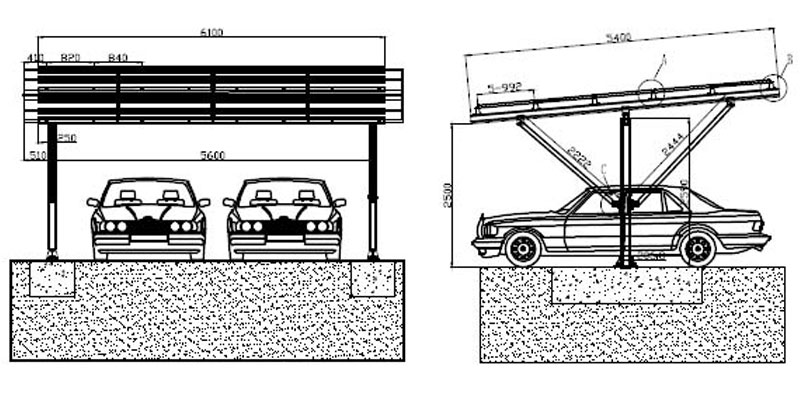What Is a Solar Carport Design?
A solar carport design combines renewable energy generation with structural and architectural aesthetics.
Unlike rooftop solar systems, carports make use of open parking areas — transforming them into dual-purpose energy assets that protect vehicles and generate electricity.
In 2025, more homeowners and commercial property owners are investing in BIPV (Building Integrated Photovoltaic) solar carports, where solar panels are not just attached, but built into the roof structure itself.
Key Elements of Modern Solar Carport Design
A successful solar carport design focuses on both engineering efficiency and visual integration. Here are the three key elements:
1️⃣ Structure Type – Choose between single-post, dual-post, or cantilever designs based on space and aesthetics.
2️⃣ Material Choice – Aluminum frames offer corrosion resistance and a sleek appearance; galvanized steel provides heavy-duty strength for commercial sites.
3️⃣ Integration Style – Traditional carports mount panels above the roof, while BIPV systems integrate solar modules directly into the structure for a streamlined, waterproof finish.
Learn more about our PV waterproof rail system, engineered for frameless bifacial panels.
Traditional Carport Design: Benefits and Limitations
Traditional carports are typically built with metal or wood frames and covered with standard roofing materials. Adding solar panels later is possible but can limit design flexibility.
Advantages:
-
Lower initial cost
-
Simple structure and faster installation
-
Flexible material options
Limitations:
-
Limited waterproofing
-
Additional mounting structure needed
-
Less visually integrated than BIPV designs
For improved weather resistance, check our waterproof structure for bifacial frameless solar panels.
BIPV Solar Carport: The Future of Solar Carport Design
A BIPV solar carport transforms the roof itself into an active energy surface.
Instead of separate solar panels mounted above, the panels are the roof — providing both aesthetic appeal and energy performance.
Benefits of BIPV Solar Carports:
-
Elegant design integration – seamless appearance without exposed brackets.
-
Full waterproofing – through specialized aluminum rails and sealing systems.
-
High energy yield – optimized panel angles for maximum sunlight capture.
-
Durability – built from anodized aluminum and tempered glass for long-term use.
See the latest innovations in our BIPV waterproof solar carport systems.
Cost Comparison & ROI (2025 Overview)
| Type | Average Cost (USD/kW) | Key Features | ROI Estimate |
|---|---|---|---|
| Traditional Solar Carport | $1,600 – $2,100 | Add-on panels, steel frame | 6–8 years |
| BIPV Solar Carport | $2,300 – $3,000 | Integrated panels, waterproof | 8–10 years |
Although the upfront investment in BIPV carports is higher, the long-term value is greater due to lower maintenance, better energy efficiency, and premium aesthetics that increase property value.
If you prefer a lighter architectural style, explore the solar pergola system as an alternative.
Frequently Asked Questions About Solar Carport Design
Q1: What is the best tilt angle for a solar carport?
A: The ideal tilt angle is typically between 5° and 15°, depending on location and latitude. This ensures maximum solar exposure and effective water drainage.
Q2: Can solar carports be fully waterproof?
A: Yes. Using BIPV systems and waterproof rails ensures total weather protection — ideal for parking lots and residential driveways.
Q3: Can BIPV carports support electric vehicle (EV) charging?
A: Absolutely. Most modern BIPV solar carports can be integrated with EV charging stations for clean, self-generated electricity.
Conclusion
In 2025, solar carport design represents the perfect balance between technology and architecture.
BIPV systems, in particular, redefine carport aesthetics — combining waterproofing, high energy yield, and modern style in one elegant solution.
Whether for homes or businesses, investing in smart solar carport design today means saving energy and shaping a sustainable future.








